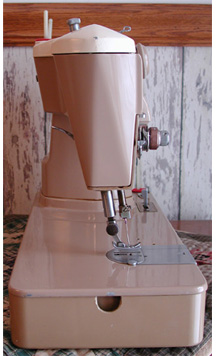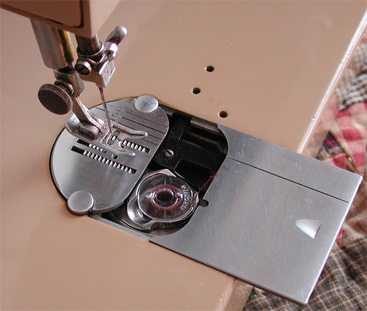 |
The image at right shows the slant of the needle bar. Additionally, the hole in the base is where the portable cabinet attaches. This is a nice design but we always double-check that the latch is secure before walking off with the machine. We will sometimes even carry the machine by putting our hands under the machine rather than relying solely on the carrying handle and the latches.
|

Singer 401A Bobbin Case Access
The image above shows why we like these machines. Note the feed dogs. Unlike many machines, there are "teeth" the full length of the pressure foot and there are also teeth behind the needle. In effect, there are twice the number of teeth here as can be found on some other machines. When a piece of fabric is started in the desired direction, the machine will pull it through very straight and the less you fuss with it, the straighter seam it will sew.
Another feature which we like is that the presser foot is 1/2-inch wide. Since we sew mostly quilt patches with a 1/4-inch seam allowance, the patches can be placed on either side of the needle and aligned with which ever side of he foot is appropriate.
There are two plates available. One is for straight-stitch sewing only and has a single small hole and referred to as AK3 because that is the setting of the dials if you don't want to break a needle. This AK3 plate provides better fabric support for straight-stitch sewing. The second plate has an elongated hole and used for other than straight-stitch sewing. A control on the machine base raises the plate (which has the effect of lowering the feed dogs) for free-form sewing.